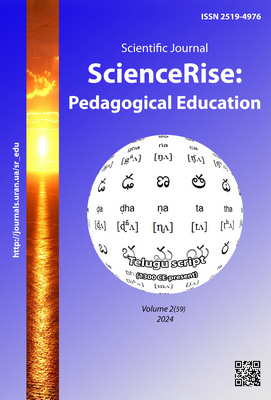Literature for children as a source of tolerance education for preschoolers
DOI:
https://doi.org/10.15587/2519-4984.2024.304675Keywords:
preschoolers, children's literature, education, tolerance, spirituality, moral values, preschool ageAbstract
The article is devoted to the topical aspect of the general problem of upbringing children of preschool age. It is emphasized that tolerance is directly related to the moral development of an individual. The educational potential of Ukrainian children's literature for preschool children is analyzed. The humanistic, competence-based, personally oriented, pedagogical, psychological approach to the education of tolerance in preschoolers is substantiated. The importance of general pedagogical principles, methods and means of educational influence on the personality of preschool children is taken into account, in particular in the education of tolerance.
A characteristic of Ukrainian classics' creativity is given in the context of enhancing the tolerance of preschool children. Education of tolerance among preschoolers by means of poetic and prose texts is revealed. An analysis of prose and verse texts for children by Ukrainian poets and writers of the second half of the 20th - beginning of the 21st century is presented. The educational potential of fairy tales, short stories, and poetry is analyzed. The necessity of using the thematic wealth of Ukrainian children's literature for the education of a tolerant person is substantiated.
The article proposes to trace the education of tolerance from folklore works to author's literature. Attention is focused on some methodical aspects of conveying the artistic word to the child. The need to involve parents in the process of raising tolerance is emphasized. On the basis of the conducted research, it was proved that children's literature is one of the effective means of forming tolerance in preschool children.
It was found that the presence of specific themes, including tolerance, plots, and images in children's books is important, however, usually the plot-image system is not a priority criterion that determines the age category of readers. More important is the criterion of appropriate selection of means of revealing the plot, building an image as a model for the child's identity, and their accessibility for children to understand. The internal contradiction of children's literature is that it has a rather rigidly defined target (age) audience, so the process of creating a work for children is difficult, and this, apparently, formed the basis of the differentiation of the meanings of children's literature and literature for children
References
- Bondarenko, N. (2010). Osoblyvosti formuvannia dukhovnykh tsinnostei u starshykh doshkilnykiv zasobamy rehionalnoi kulturno-istorychnoi spadshchyny. Doshkilna osvita, 1 (27), 75–82.
- Delenko, V. B. (2017). Kharakterystyka ta umovy formuvannia tolerantnosti u pedahohichnomu seredovyshchi. Nastupnist doshkilnoi ta pochatkovoi osvity v konteksti sotsialnoi mobilnosti. Lviv: LNU imeni Ivana Franka, 68–71.
- Honcharenko, A. M. (2003). Pedahohichni umovy stanovlennia humannykh vzaiemyn starshykh doshkilnykiv. [Dys. … kand. ped. nauk; Instytut problem vykhovannia APN Ukrainy].
- Havrysh, N. (2011). Khudozhnia literatura v osvitnomu protsesi: suchasni tekhnolohii. Doshkilne vykhovannia, 2, 4–9.
- Bohdanets-Biloskalenko, N. (2023). Children’s literature as an important component in education for tolerance of preschool children. Acta Paedagogica Volynienses, 1, 10–17. https://doi.org/10.32782/apv/2023.1.2
- Bohdanets-Biloskalenko, N. I. (2012). U barvystomu vinochku. Khrestomatiia. Navch.posibnyk dlia roboty z ditmy u doshkiln.navch.zakladakh. Kyiv: Vydavnychyi Dim «Slovo», 728.
- Vovk, O. (2009). Osnovni zavdannia ukrainskoi dytiachoi literatury (rozdumy nad problemoiu). Aktualni problemy slovianskoi filolohii. Linhvistyka i literaturoznavstvo, 20, 242–249.
- Delenko, V. (2018). Ukrainska dytiacha literatura yak dzherelo vykhovannia tolerantnosti v ditei doshkilnoho viku. Pedahohichni nauky: realii ta perspektyvy, 61 (5), 77–80.
- Pobirchenko, N. S. (2004). Vasyl Sukhomlynskyi: formuvannia dytiachoi osobystosti zasobamy khudozhnoi literatury. Pedahohika i psykholohiia, 1 (42), 5–12.
- Budnyk, O., Rembierz, M., Arbeláez-Encarnación, T. F., Rojas-Bahamón, M. J., Arbeláez-Campillo, D. F., Chinchoy, A., Matveieva, N. (2022). Formation of tolerance in the inclusive environment of an educational institution. Revista Amazonia Investiga, 11 (56), 305–319. https://doi.org/10.34069/ai/2022.56.08.29
Downloads
Published
How to Cite
Issue
Section
License
Copyright (c) 2024 Valentyna Delenko, Ilona Hnatyshak, Olena Lushchynska

This work is licensed under a Creative Commons Attribution 4.0 International License.
Our journal abides by the Creative Commons CC BY copyright rights and permissions for open access journals.
Authors, who are published in this journal, agree to the following conditions:
1. The authors reserve the right to authorship of the work and pass the first publication right of this work to the journal under the terms of a Creative Commons CC BY, which allows others to freely distribute the published research with the obligatory reference to the authors of the original work and the first publication of the work in this journal.
2. The authors have the right to conclude separate supplement agreements that relate to non-exclusive work distribution in the form in which it has been published by the journal (for example, to upload the work to the online storage of the journal or publish it as part of a monograph), provided that the reference to the first publication of the work in this journal is included.








